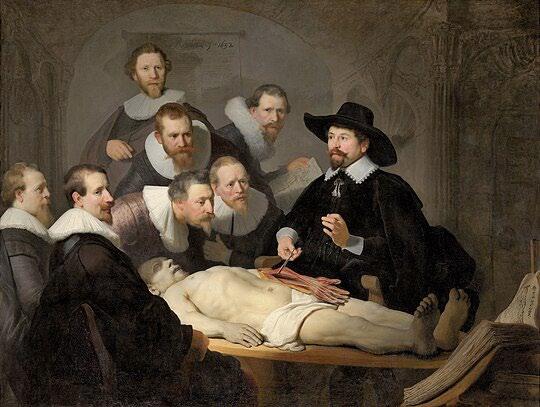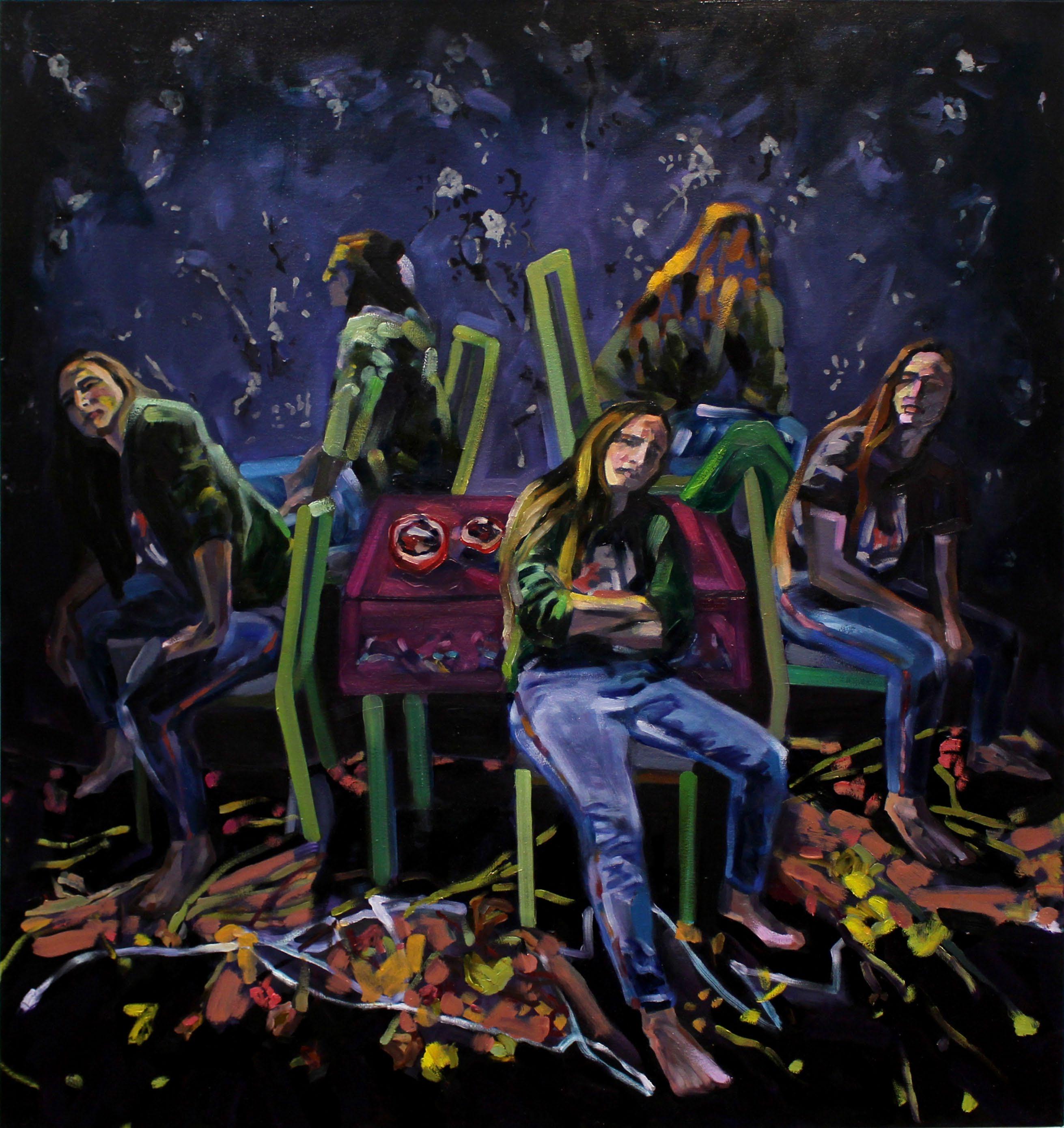ANATOMY OF AN ARTIST AND THEIR ARTIFICIAL SELF
BY LELIA BYRON
IN COLABORATION WITH NICOLÁS GARCÍA TRILLOS
RIT BEVIER GALLERY 2024
ACKNOWLEDGEMENTS
THANK YOU TO ALL OF THE FRIENDS AND COLLEAGUES WHO POSED FOR REFERENCE IMAGES FOR THE PAINTING OR WERE THERE TO CONSULT WITH ABOUT DIFFERENT IDEAS AND PROBLEMS: RITA CASTANHEIRA, KA IAN HOI, BO FAN, MATT JACOBS, LEON BUNGERT, TRE’MAR BAPTISTE, KONSTANTIN RIEDL, SIXU LI, NICOLÁS CERQUERA. THANK YOU TO ANNIKA KECKHAVER. THANK YOU TO JOHN AASP, SHANE DURGEE, AND THE BEVIER GALLERY STAFF. WE HAD THE INITIAL IDEA FOR THE TOPIC OF THIS EXHIBITION BACK IN 2019. AT THE TIME, HOWEVER, THERE WAS NOT TOO MUCH INTEREST IN TALKING ABOUT ARTIFICIAL INTELLIGENCE THROUGH ART FROM ART INSTITUTIONS. WE’D LIKE TO THANK RIT, WHO, ON THE OTHER HAND, WAS ENTHUSIASTIC ABOUT THE PROJECT FROM THE MOMENT WE MENTIONED IT A FEW YEARS AGO.
THIS EXHIBITION IS SUPPORTED BY THE ANNA BALLARIAN VISITING ARTIST SERIES.
ANATOMY OF AN ARTIST AND THEIR ARTIFICIAL SELF
TEXT BY LELIA BYRON AND NICOLÁS GARCÍA TRILLOS
In the midst of expanding media attention surrounding artificial intelligence, some voices have expressed concern about the risks that this set of technologies, highly dependent on the collection of data, impose. Within these voices, some describe dystopian scenarios similar to plots from 20thcentury science fiction novels. Other voices, less alarmist than the previous ones, are skeptical about the true capacity of these technologies and point out that the success stories around AI, at least for the moment, have been overstated to benefit the voracious commercial interests of large companies and investors. Yet, regardless of the overall perspective taken on the topic, AI technologies are already deeply impacting and transforming human behavior at individual and collective levels: how people spend their leisure time, how people communicate with each other, how preferences are shaped, how information and misinformation have influenced a variety of collective actions, and how decisions are made, from judges making decisions about parole to people choosing clothing sizes when shopping online.
This exhibition, consisting of a series of hand-made paintings made by artist Lelia Byron and an installation of images produced through the use of AI technologies made collaboratively with Nicolás García Trillos, Professor in the Statistics Department at UW Madison, seeks to explore the relationship between AI technologies and the
creative process of an artist and, more broadly, examines a fundamental question: how does a creator respond when they see their own creation come to life and find themselves being shaped by their own creations?
The exhibition is structured in three parts that evoke the architecture of Dante’s Divine Comedy. Byron and García Trillos use this allusion to Dante and his work to convey a path that begins with isolation and confinement and rises up toward reunion and expression.
The allusion also allows them to explore the inversion of roles that is latent in the relationship between human beings and AI: creations can become creators that can then acquire the ability to shape their creator, who in turn becomes a creation.
All in all, the visitor to this exhibition is invited to embark on a creative journey emulating that of the artists’, who, like Dante, have gone in search of personal and mysterious corners of the anatomy of their human condition.
RIT BEVIER GALLERY 2024 2
ANATOMIES FROM ARCHITECTURES

INSTALLATION OF 500 UNIQUE PHOTOGRAPHS, RED STRING, AND PAINTED MATS. 2024.

3
ANATOMY OF AN ARTIST AND THEIR ARTIFICIAL SELF - PART 1
While passing through the Ante-Purgatory, Dante hears the following words from one of the souls: “Whoever you are, walking as you go, turn your face towards me and try to remember if you have ever seen me in the world.”
THESE WORDS COULD ACT AS A SUMMARY FOR THIS INSTALLATION, SINCE THE 500 PHOTOGRAPHS THAT FORM IT PORTRAY PEOPLE WHO DO NOT EXIST IN REAL LIFE AND WHO, INSTEAD, WERE GENERATED BY A COMPUTER.
In general, the image generation process has two phases. The first is the training process, where millions of images of real people (mostly taken from selfies sent by social media users) guide the optimization of a learning model and its architecture. The second phase is the generation process itself, where random noise is converted by the trained model into the image of a human being. The images used during the training stage, those that belonged to real people, then become like shadows of the people they represent—shadows that are now confined to living in the memory of a server or a computer to obey the whims of it and its users.
FOR THE INSTALLATION, BYRON AND GARCÍA TRILLOS USED A PRETRAINED APPLICATION THAT ALLOWS YOU TO SPECIFY TEXT AND OTHER IMAGE PROMPTS TO GUIDE THE GENERATION PROCESS.
In choosing their prompts, they sought to create a wide variety of selfie-like images exploring specific color patterns, different photographic and light qualities, different time periods and locations, different climatic conditions, and most importantly, images that tell diverse stories from a wide variety of “people.” In this network of sometimes seemingly familiar faces, they are both in conversation with each other and simultaneously disconnected from one another.
HOWEVER, THE ISSUE OF THE GENERATION OF HUMAN BEINGS IN THIS INSTALLATION GOES BEYOND THE SIMPLE GENERATION OF IMAGES, AND IN PARTICULAR, THE INSTALLATION SEEKS TO DRAW ATTENTION TO THE FREEDOM WITH WHICH THESE NEW TECHNOLOGICAL PLATFORMS CAN USE PERSONAL DATA FOR PURPOSES WITH HARMFUL SOCIETAL CONSEQUENCES.
4 RIT BEVIER GALLERY 2024




5 ANATOMY OF AN ARTIST AND THEIR ARTIFICIAL SELF - PART 1




6 RIT BEVIER GALLERY 2024
DETAIL VIEW OF A FEW OF THE 500 UNIQUE PHOTOGRAPHS.
THE ANATOMY LESSON

7
ON
ANATOMY OF AN ARTIST AND THEIR ARTIFICIAL SELF - PART 2
OIL
CANVAS, 5 X 5 FEET, 2024.
INSPIRED BY THE PAINTING THE ANATOMY LESSON OF DR. NICOLAES TULP BY REMBRANDT, THIS PAINTING SEEKS TO CAPTURE THE PROCESS OF INTROSPECTION OF THE HUMAN BEING CONSIDERING HOW EMBEDDED WITHIN HER BEING ARE ARTIFICIAL INTELLIGENCE TECHNOLOGIES.
It is clear that the inspection does not have to be very deep to be able to detect the presence of these technologies in the daily lives of human beings and see some of their effects on them, from inducing people to buy unnecessary consumer products to suggesting individuals through dating applications. It is not very clear, however, what would be found if the inspection were more in-
depth, and it is even less clear what treatment to follow once the diagnosis is known after such an inspection. Is it removed, are some elements adjusted for a partial change in anatomy, or is the diagnosis simply ignored?
Rembrandt’s disturbing painting, commissioned in 1632 by the Amsterdam surgeons’ guild, has an even more disturbing reallife backstory. The scene portrays Dr. Tulip, those attending an anatomy session, and, in the center, the body of a man who had a death sentence. At that time, anatomy sessions open to the public occurred with some frequency. In them, anyone interested could observe everything that each person carried inside.

8
RIT BEVIER GALLERY 2024

ANATOMY OF AN ARTIST AND THEIR ARTIFICIAL SELF - PART 2 9
OIL ON CANVAS, 5 X 5 FEET, 2024.
PERSEPHONE’S HEART
Far from being simple spaces for efficient communication, social networks have become spaces where their users spend long periods of time in their lives. Some consequences of this permanent connection include depression, anxiety, and a pronounced and enveloping sense of loneliness.
IN THIS PAINTING, BYRON SEEKS TO CAPTURE THIS SENSATION AND CREATES A PARALLEL BETWEEN IT AND THE MYTH OF PERSEPHONE, WHOSE HEART, IN THE SHAPE OF A POMEGRANATE, IS PORTRAYED IN THE CENTER OF THE PAINTING. ORDINARY STORIES.
Persephone, who eats the fruit given to her by Hades, is condemned to live in a cycle of life and death. When summer arrives, Persephone heads to the underworld, where she stays until the beginning of a new cycle, when she returns to this world with the arrival of spring. No one accompanies her in this endless cycle. Not even Hades, whom, in some versions of the myth, Persephone had finally come to accept.
RIT BEVIER GALLERY 2024 10

ACT 1: THE MESSAGE
IN THE FIRST ACT OF THE IMAGINARY PLAY REPRESENTED IN THIS PAINTING, A GROUP OF FRIENDS DISCUSS THE CONTENT OF A MESSAGE SENT BY ONE OF THEM TO THE REST OF THE GROUP.
Initial disagreements lead some members of the group to a higher level of disagreement, and the group eventually divides into sides. Disenchanted and apathetic, the woman in the middle sees that the possibility of an end to the discussion that began with the message is receding.
11 OIL ON CANVAS, 7 X 5 FEET, 2024.
ANATOMY OF AN ARTIST AND THEIR ARTIFICIAL SELF - PART 2

ACT 2: THE END OF THE CONVERSATION
THE PLAY’S DIALOGUE IS NOW IN FULL CHAOS.
Each of the friends has already established their own position and begins to view the others with suspicion. There is no way to listen to distinguish one voice, as all you can hear is increasing shouting. The conversation has come to an end. The actors leave the stage. The audience applauds and then leaves.
12 RIT BEVIER GALLERY 2024 OIL ON CANVAS, 7 X 5 FEET, 2024.
REUNITED
OIL ON CANVAS, 20 X 9 FEET, 2024.

13
ANATOMY OF AN ARTIST AND THEIR ARTIFICIAL SELF - PART 3

Just as he must have felt satisfaction in sentencing his political enemies and other historical figures with adverse interests to his own to confinement and isolation in his writing, Dante must have felt extremely emotional when imagining his passage through the world of the divine hand in hand with his love, Beatrice, who had died several years earlier.
This painting, created as a single 20x9 ft. panel, depicts the happy, although impossible, reunion of real people from Byron’s life. The photographs that served as the artist’s reference for
this painting cover multiple time periods and places that the artist keeps in her memory.
In the face of distance, uncertainty, and the irreversibility of some painful moments in life, creativity can often emerge as a powerful human resource. This creative power can transform conflicting emotions such as happiness and sadness into a single painting and, in the end, materialize impossible situations, such as bringing together people who live in different places and times, some of them already deceased.
Ultimately, the painting serves as a contrast to the images in Anatomies From Architectures, and asks us to consider the difference between generating images through artificial intelligence and creating artwork that can portray both a very specific individual point of view and relate to universal questions surrounding humanity.
14
RIT BEVIER GALLERY 2024

















